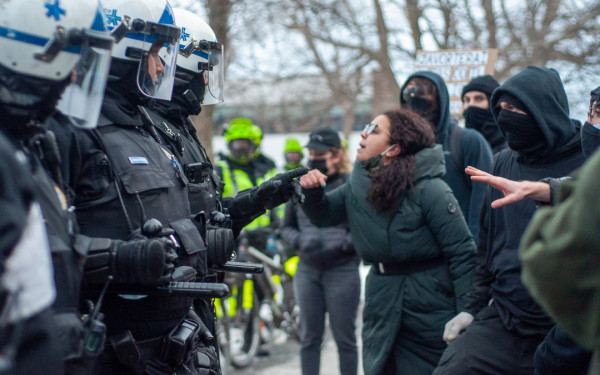Editorial: Bylaw P-6 Does Not Maintain Order
Protesters waited until the eve of the municipal election to hold a march against bylaw P-6.
The demonstration reinforced just how arbitrary the bylaw’s application has become.
Despite a heavy police presence, no arrests were made. But it could have just as easily ended in kettling—as many protests with similar moods and numbers have in the last 18 months.
The bylaw was originally enacted under Bill 78, which mandated that protest routes must be declared to authorities at least eight hours before the protest begins. It was later amended to increase fines and include the prohibition of wearing masks during protests.
In opposition to the bylaw, masked protesters met Saturday and marched through the Plateau, in what may have looked like a heavily monitored post-Halloween trick-or-treat march to bystanders.
Police followed closely, keeping protesters off sidewalks and setting up blockades on adjoining streets. It was obvious from the beginning that the Service de police de la Ville de Montréal had the capacity to shut down the protest at any point.
But that didn’t happen, even after protesters started walking against traffic—often a trigger for mass arrests.
Based on precedent, many in attendance were probably expecting arrests during the demonstration. If they were looking for police backlash to fuel more opposition to P-6, Saturday’s protesters were left disappointed.
Why the protest was not shut down is not clear. Whoever gives the order from on high to either quash or allow non-violent demonstrations seems to do so based on their star chart and/or augury.
Recent protests such as those in opposition to the proposed Charter of Quebec Values—some of which according to the bylaw are technically illegal—have continually not been shut down by police authorities—perhaps because those on both sides of the issue have been taking to the streets.
On the other hand, protests such as a demonstration held on Oct. 9 in protest of Enbridge’s bid to send crude oil from Western Canada and the United States through Quebec, was shut down promptly under P-6.
So then what’s the purpose of this bylaw? Maintaining order doesn’t seem like a valid reason while some non-violent marches are made freer than others. Or is it a continuation of the same kind of political profiling we saw during the student strike?
At some point, however, the directive has to be given from city hall.
The election of Mayor Denis Coderre has dispelled any near-hope for reforming the controversial bylaw. Coderre has stated that he agrees that protest routes should necessarily be declared, and that masks should be prohibited during demonstrations.
The outcome of Sunday’s election doesn’t spell only bad news for our freedom to demonstrate, however. Projet Montréal, the only party against the bylaw amendments made during the Maple Spring, also made significant gains, and now hold 20 city council seats to Coderre’s 27.
Hopefully, having a party that has already tried to repeal the amendments as the official opposition will mean more noise will be made about the unconstitutional municipal legislation at city hall.
But with Coderre as mayor, it’s unlikely that we will see these amendments disappear through political means over the next four years. It means for many that the only way forward is through continued civil disobedience and demonstration.
With this inconsistent, draconian law, it seems we’re just bound to see the same kind of protest action once Montreal thaws again this spring.


_600_832_s.png)



1web_600_375_90_s_c1.jpg)
_600_375_90_s_c1.jpg)